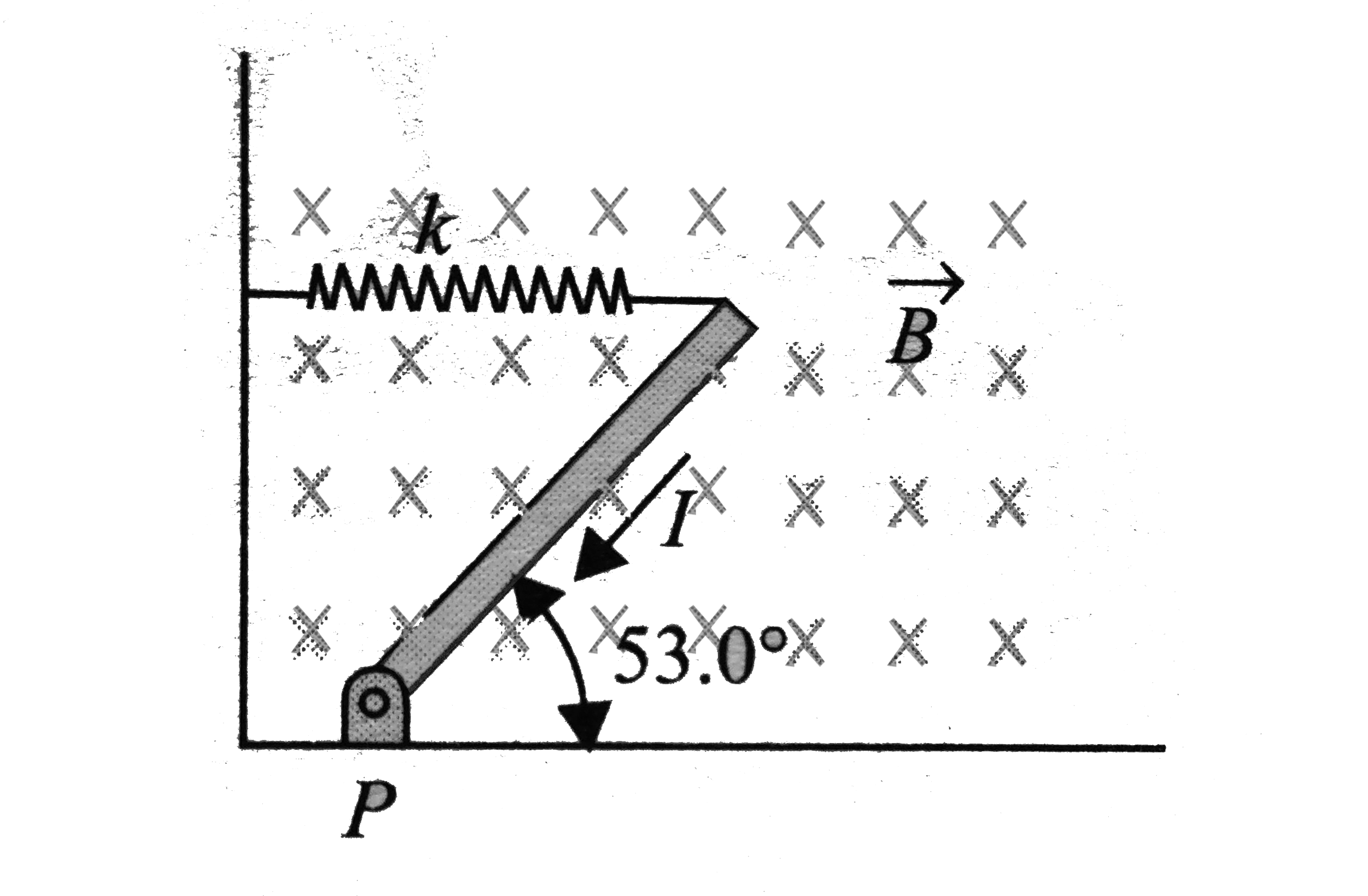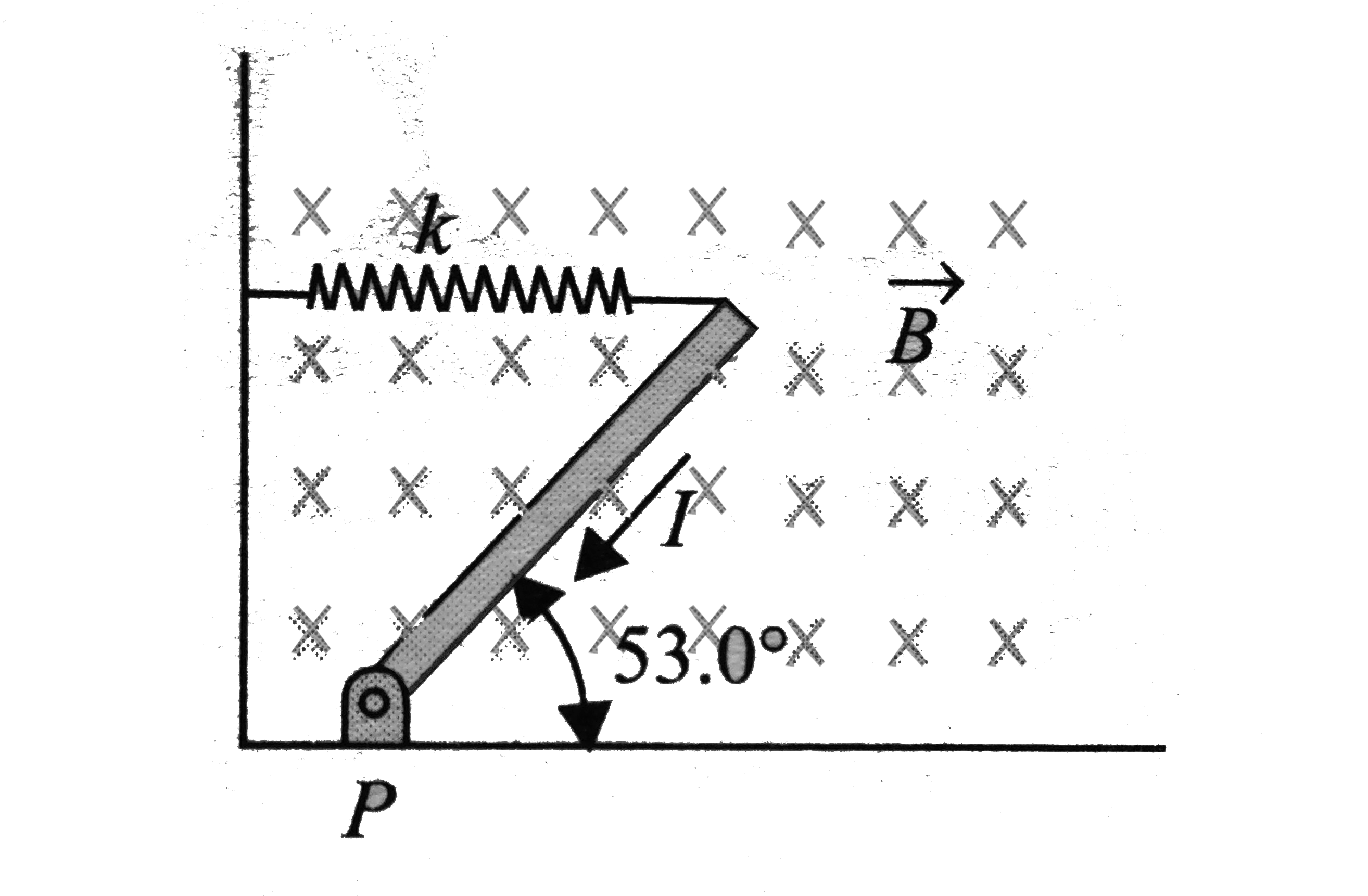A thin, uniform rod with negligible mass and length 0.200m is attached to the floor by a frictionless hinge at point P (as shown in fig) A horizontal spring with force constant k=4.80Nm−1 connects the other end of the rod to a vertical wall. The rod to a vertical wall. The rod is in a uniform magnetic field B=0.340T directed into the plane of the figure. There is current I=6.50 A in the rod, in the direction shown.

When the rod is in equilibrium and makes an angle of 53.0∘ with the floor, is the spring stretched or compressed?
The correct Answer is:A, C
a. Yes, magnetic force for calculation of torque can beassumed at centre. Since variatonof torque about P from one end of the rod to the other end comes out to be linear.
∴τ=(IlB)(l2)=Il2B2
=(6.5)(0.2)2(0.34)2
=0.0442N−m
b. Magnetic torque on rod will come out to be clockwise. Therfore, torque of spring force should be anticlockwise or spring should be stretched.
b. In equilibrium,
clockwise torque of magnetic force
=anticlockwise torque of spring force
∴0.0442=(kx)(lsin53∘)=(4.8)(x)(0.2)(45)
orx=0.057m
U=12kx2=12×(4.8)(0.057)2
=7.8×10−3J
Topper's Solved these Questions
- BOOK - DC PANDEYCHAPTER - MAGNETICSEXERCISE - INTRODUCTORY EXERCISE1videos
MAGNETICS
- BOOK - DC PANDEYCHAPTER - MAGNETICSEXERCISE - SUBJECTIVE_TYPE1videos
MAGNETICS
- BOOK - DC PANDEYCHAPTER - MAGNETICSEXERCISE - MCQ_TYPE1videos
MAGNETICS
- BOOK - DC PANDEYCHAPTER - MAGNETIC FIELD AND FORCESEXERCISE - Medical entrance s gallery59videos
MAGNETIC FIELD AND FORCES
- BOOK - DC PANDEYCHAPTER - MAGNETISM AND MATTEREXERCISE - Medical gallery1videos
MAGNETISM AND MATTER
Similar Questions
Figure given in the question is a cross-sectional view of a coaxial cable. The centre conductor. surrounded by a rubber layer, which is surrounded by an outer conductor, which is surround by another rubber layer. The current in the inner conductor is 1.0A out of the page, and the current in the outer conductor is 3.0 A into the page. Determine the magnitude and direction of the magnetic field at points a and b.
 07:08View Solution
07:08View SolutionIn the Bohr model of the hydrogen atom, in the lowest energy state the electron revolves round the proton at a speed of 2.2×106ms in a circular orbit of radius 5.3×10−11 m.
(a) What is the orbital period of the electron?
(b) If the orbiting electron is considered to be a current loop, what is the current I? (c) What is the magnetic moment of the atom due to the motion of the electron?05:58View SolutionTwo circular coil of radii 5cm and 10cm carry equal currents of 2A. The coils have 50 and 100 turns, respectively, and are placed in such a way that their planes as well as their centers coincide. Magnitude of magnetic field at the common centre of coils is
05:58View SolutionA long wire carries a steady curent . It is bent into a circle of one turn and the magnetic field at the centre of the coil is B. It is then bent into a circular loop of n turns. The magnetic field at the centre of the coil will be
03:19View SolutionA bar magnet is hung by a thin cotton thread in a uniform horizontal magnetic field and is in equilibrium state. The energy required to rotate it by 60∘ is W. Now the torque required to keep the magnet in this new position is
02:35View SolutionA uniform rod AB hinged about a fixed point P is initially vertical. A rod is released from vertical position. When rod is in horizontal position: The acceleration of end B of the rod is
View SolutionA thin, uniform rod with negligible mass and length 0.200m is attached to the floor by a frictionless hinge at point P (as shown in fig) A horizontal spring with force constant k=4.80Nm−1 connects the other end of the rod to a vertical wall. The rod to a vertical wall. The rod is in a uniform magnetic field B=0.340T directed into the plane of the figure. There is current I=6.50 A in the rod, in the direction shown.

Calculate the torque due to the magnetic force on the rod, for an axis at P.View SolutionA thin, uniform rod with negligible mass and length 0.200m is attached to the floor by a frictionless hinge at point P (as shown in fig) A horizontal spring with force constant k=4.80Nm^-1 connects the other end of the rod to a vertical wall. The rod to a vertical wall. The rod is in a uniform magnetic field B=0.340T directed into the plane of the figure. There is current I=6.50 A in the rod, in the direction shown. When the rod is in equilibrium and makes an angle of 53.0^@ with the floor, is the spring stretched or compressed?
04:57View SolutionA thin uniform rod with negligible mass and length l is attached to the floor by a frictionless hinge at point P. A horizontal spring with force constant k connects the other end to wall. The rod is in a uniform magnetic field B directed into the plane of paper. What is extension in spring in equilibrium when a current is passed through the rod in direction shown? Assuming spring to be in natural length initially and it remains perpendicular to wall always.
 View Solution
View SolutionIn the figure a uniform rod of mass 'm' and length 'l' is hinged at one end and the other end is connected to a light vertical of spring constant 'k' as shown in figure. The spring has extension such that rod is equilibrium when it is horizontal . The rod rotate about horizontal axis passing through end 'B' . Neglecting friction at the hinge find (a) extension in the spring (b) the force on the rod due to hinge.
11:06View SolutionA uniform rod of mass M and length L is hinged at its end to a wall so that it can rotate freely in a horizontal plane. When the rod is perpendicular to the wall a constant force F starts acting at the centre of the rod in a horizontal direction perpendicular to the rod. The force remains parallel to its original direction and acts at the centre of the rod as the rod rotates. (Neglect gravity). (a) With what angular speed will the rod hit the wall ? (b) At what angle theta (see figure) the hinge force will make a 45^(@) angle with the rod ?
03:30View SolutionConsider the situation shown in the figure. Uniform rod of length L can rotat freely about the hinge A in vertical plane. Pulleys and stringa are light and frictionless. If the rod remains horizontal at rest when the system is released then the mass of the rod is
03:41View SolutionA long uniform rod of length L, mass M is free to rotate in a horizontal plane about a vertical axis through its end. Two springs of constant K each are connected as shown. On equilibrium, the rod was horizontal. The frequency will be –
05:18View SolutionPassage - II :
Uniform rod AB hinged about a fixed point 'P' is initially vertical. Rod is released from vertical position. When rod is in horizontal position.

The acceleration of end B of rod is04:37View SolutionA thin, uniform rod with negligible mass and length 0.200m is attached to the floor by a frictionless hinge at point P (as shown in fig) A horizontal spring with force constant k=4.80Nm−1 connects the other end of the rod to a vertical wall.The rod is in a uniform magnetic field B=0.340T directed into the plane of the figure. There is current I=6.50 A in the rod, in the direction shown.

When the rod is in equilibrium and makes an angle of 53.0∘ with the floor, is the spring stretched or compressed?06:23View SolutionConsider the situation shown in the figure. Uniform rod of length L can rotat freely about the hinge A in vertical plane. Pulleys and stringa are light and frictionless. If the rod remains horizontal at rest when the system is released then the mass of the rod is
View Solution

